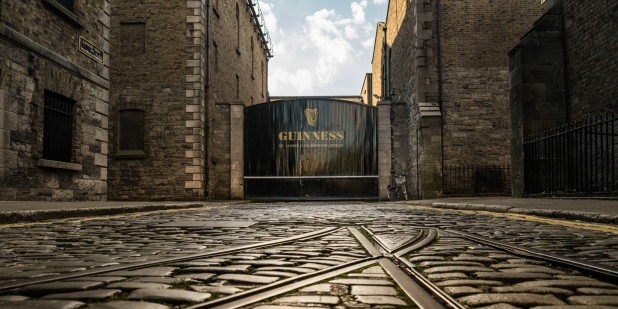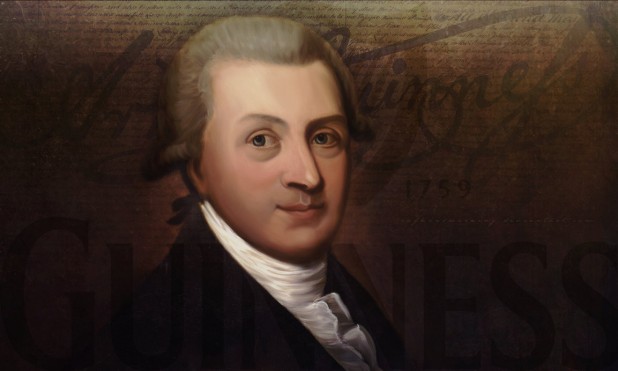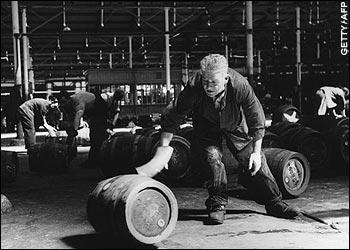Arthur Guinness was born in Celbridge, Co Kildare in 1725. His mother Elizabeth Read was born in Oughterard. His father, Richard Guinness was the Land Steward to the Archbishop of Cashel Most Rev. Arthur Price. Richard was responsible for the brewing of beer for the estate’s workers. Arthur helped him with this and he discovered the art of brewing beer from a young age. Arthur Price died in 1752 and he left Richard and Arthur £100 in his will. This was a huge sum of money back then. Arthur decided to develop a brewery in Leixlip in 1756. Three years later he asked his younger brother to take control of the brewery, while he opened another brewery in St James’s Gate in Dublin. He paid an annual rent of €45 every year, and the terms of the lease were to continue for 9000 years.
He started brewing ale and beer, and eight years later he became the master of the Dublin Cooperation of Brewers. He met Olivia Whitmore, a cousin of Henry Grattan in 1761. Olivia was very well connected in Dublin’s society. Arthur had 21 children with Olivia. Sadly only 10 of their children survived until adulthood. Three of his sons came to work with him in the brewery.
In 1770 Arthur decided to create a different kind of ale. This beer was made from roasted barley. It was dark in colour and was called ‘porter’. This later became known as ‘Guinness’. Arthur died in 1803, and he was buried in Oughterard. However his legacy lived on. His great grandson Edward Cecil Guinness set up employee welfare schemes in the late 19th to early 20th century. This was before free health care and pensions were introduced by the State. He established St Stephen’s Green Park and gave it to the people of Dublin in 1880. He also restored the Marsh’s Library and extended the Coombe Women’s hospital. He launched the Guinness Trust in London in 1890. This comprised of social housing for people who were living in the slums. He was given the title of ‘Lord Iveagh’ by Queen Victoria for his charitable deeds. He established the Iveagh Gardens which was the Dublin branch of the Guinness Trust in 1903. He was renowned for his philanthropic work of helping the poor in both Dublin, and London. Edward died in 1927, and was buried in Elveden, Suffolk, in England.
Throughout the 1930’s people were dependent on the brewery for their livelihood. If you received a job in Guinness’s, you were set up for life. The Guinness family really looked after their employees. They paid for healthcare, not just for their employees, but for their entire family. On retirement the pension provided never required contributions. They received free meals daily and had access to co-operative stores, where their work clothes were bought at a reduced rate. The old saying from the employees working for Guinness’s was that you were cared for ‘from the womb to the tomb.’ They developed the Thomas Court houses and houses in Rialto Street for their employees. The houses in Rialto Street are still here today.
Many of the cottages and flats in the Liberties area were built by Guinness’s. In 1914 the brewery built more houses, the Iveagh Gardens in Crumlin, and Corrib Road in Terenure. There were seven different generations involved in the Guinness brewery. Today the Guinness Storehouse is one of the biggest tourist attractions in the Dublin city. It is the largest brewer of stout in the world.
In 2012 Diageo, the parent company of Guinness’s, established an initiative called ‘Learning for Life’ which is running for its third year in Ireland. This initiative was aimed to help young people in the Liberties area, Dublin 1 and Dundalk to gain employment, because there is a high level of unemployment in these locations. The first year was geared towards the Liberties area. The second year was aimed at the Liberties and Dublin 1, and it is currently running in Dundalk. The scheme involves classroom training and mentor placements in pubs and hotels. Its purpose is to help them to achieve employment in the hospitality sector. It has been a successful scheme to date.
I interviewed a local man from Church Street, who is an employee of the Guinness Storehouse.
Darren Kenny, employee of the Guinness Storehouse
“I first started working here in February of this year. I came in through a recruitment company and I was just doing cover hours and I was filling in when needed. Then I progressed on to a summer contract, and now thankfully, I have a permanent position. I am currently a Guinness Beer Specialist. This involves talking about Guinness to the visitors. I get to speak about new beers, about their history, where they are made and to promote the brand. I have received extensive training since I have started working here. This training was for tours, bar procedures and now I’m learning connoisseur experience.
We are always upskilling here; it is a place where you can grow. I was born and bread in Church Street, it is only a 7 minute walk for me to get to work. My favourite aspect of the job is getting to speak to people who have similar interests to me. Being a local lad, I can offer something different, that other people who work here can’t. It has a sort of nostalgia for me. It is a very friendly place to work in. We are hired for our personality here. If you are feeling a bit down when you come in, people cheer you up. You get your brief in the morning and then we begin our day. The visitors are also in good spirits because they are on holiday, and they are looking forward to the tour. The Guinness Storehouse to me is a great place to work.”











